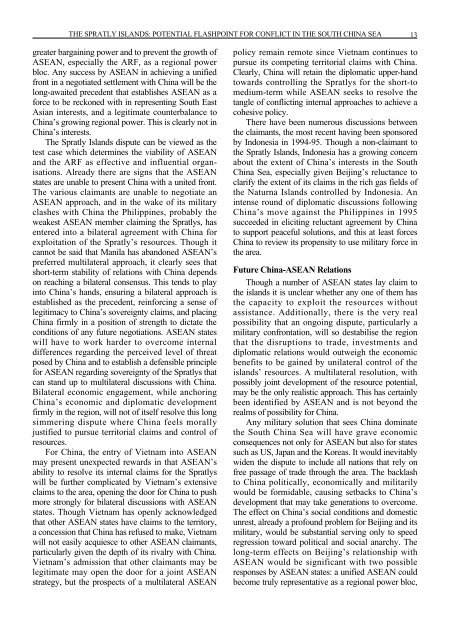ISSUE 125 : Jul/Aug - 1997 - Australian Defence Force Journal
ISSUE 125 : Jul/Aug - 1997 - Australian Defence Force Journal
ISSUE 125 : Jul/Aug - 1997 - Australian Defence Force Journal
Create successful ePaper yourself
Turn your PDF publications into a flip-book with our unique Google optimized e-Paper software.
THE SPRATLY ISLANDS: POTENTIAL FLASHPOINT FOR CONFLICT IN THE SOUTH CHINA SEA 13greater bargaining power and to prevent the growth ofASEAN, especially the ARF, as a regional powerbloc. Any success by ASEAN in achieving a unifiedfront in a negotiated settlement with China will be thelong-awaited precedent that establishes ASEAN as aforce to be reckoned with in representing South EastAsian interests, and a legitimate counterbalance toChina’s growing regional power. This is clearly not inChina’s interests.The Spratly Islands dispute can be viewed as thetest case which determines the viability of ASEANand the ARF as effective and influential organisations.Already there are signs that the ASEANstates are unable to present China with a united front.The various claimants are unable to negotiate anASEAN approach, and in the wake of its militaryclashes with China the Philippines, probably theweakest ASEAN member claiming the Spratlys, hasentered into a bilateral agreement with China forexploitation of the Spratly’s resources. Though itcannot be said that Manila has abandoned ASEAN’spreferred multilateral approach, it clearly sees thatshort-term stability of relations with China dependson reaching a bilateral consensus. This tends to playinto China’s hands, ensuring a bilateral approach isestablished as the precedent, reinforcing a sense oflegitimacy to China’s sovereignty claims, and placingChina firmly in a position of strength to dictate theconditions of any future negotiations. ASEAN stateswill have to work harder to overcome internaldifferences regarding the perceived level of threatposed by China and to establish a defensible principlefor ASEAN regarding sovereignty of the Spratlys thatcan stand up to multilateral discussions with China.Bilateral economic engagement, while anchoringChina’s economic and diplomatic developmentfirmly in the region, will not of itself resolve this longsimmering dispute where China feels morallyjustified to pursue territorial claims and control ofresources.For China, the entry of Vietnam into ASEANmay present unexpected rewards in that ASEAN’sability to resolve its internal claims for the Spratlyswill be further complicated by Vietnam’s extensiveclaims to the area, opening the door for China to pushmore strongly for bilateral discussions with ASEANstates. Though Vietnam has openly acknowledgedthat other ASEAN states have claims to the territory,a concession that China has refused to make, Vietnamwill not easily acquiesce to other ASEAN claimants,particularly given the depth of its rivalry with China.Vietnam’s admission that other claimants may belegitimate may open the door for a joint ASEANstrategy, but the prospects of a multilateral ASEANpolicy remain remote since Vietnam continues topursue its competing territorial claims with China.Clearly, China will retain the diplomatic upper-handtowards controlling the Spratlys for the short-tomedium-term while ASEAN seeks to resolve thetangle of conflicting internal approaches to achieve acohesive policy.There have been numerous discussions betweenthe claimants, the most recent having been sponsoredby Indonesia in 1994-95. Though a non-claimant tothe Spratly Islands, Indonesia has a growing concernabout the extent of China’s interests in the SouthChina Sea, especially given Beijing’s reluctance toclarify the extent of its claims in the rich gas fields ofthe Naturna Islands controlled by Indonesia. Anintense round of diplomatic discussions followingChina’s move against the Philippines in 1995succeeded in eliciting reluctant agreement by Chinato support peaceful solutions, and this at least forcesChina to review its propensity to use military force inthe area.Future China-ASEAN RelationsThough a number of ASEAN states lay claim tothe islands it is unclear whether any one of them hasthe capacity to exploit the resources withoutassistance. Additionally, there is the very realpossibility that an ongoing dispute, particularly amilitary confrontation, will so destabilise the regionthat the disruptions to trade, investments anddiplomatic relations would outweigh the economicbenefits to be gained by unilateral control of theislands’ resources. A multilateral resolution, withpossibly joint development of the resource potential,may be the only realistic approach. This has certainlybeen identified by ASEAN and is not beyond therealms of possibility for China.Any military solution that sees China dominatethe South China Sea will have grave economicconsequences not only for ASEAN but also for statessuch as US, Japan and the Koreas. It would inevitablywiden the dispute to include all nations that rely onfree passage of trade through the area. The backlashto China politically, economically and militarilywould be formidable, causing setbacks to China’sdevelopment that may take generations to overcome.The effect on China’s social conditions and domesticunrest, already a profound problem for Beijing and itsmilitary, would be substantial serving only to speedregression toward political and social anarchy. Thelong-term effects on Beijing’s relationship withASEAN would be significant with two possibleresponses by ASEAN states: a unified ASEAN couldbecome truly representative as a regional power bloc,
















